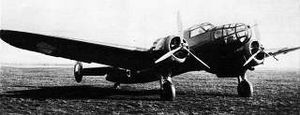
The Aero A.14 was a Czechoslovakian biplane military reconnaissance aircraft built in the 1920s. It was essentially a slightly modified version of the Hansa-Brandenburg C.I aircraft that Aero had built during World War I as the Ae.10, and for this reason, the aircraft is sometimes referred to as the A.14 Brandenburg. When equipped with a slightly different engine, the aircraft was designated A.15 instead. The two versions were otherwise almost identical.

The Aero A.32 was a biplane built in Czechoslovakia in the late 1920s for army co-operation duties including reconnaissance and tactical bombing. While the design took the Aero A.11 as its starting point, the aircraft incorporated significant changes to make it suited for its new low-level role.

The Aero A.42 was a Czechoslovakian bomber aircraft of 1929 that was only ever produced in prototype form. For its day, it was an advanced design, with a sleek monoplane configuration. However, the Czechoslovak Air Force was not satisfied with it for a number of reasons. In particular, the aircraft's take-off and landing runs were felt to be excessively long, and crew complained about the cramped cabin. The air force suggested a set of modifications to Aero, including replacing the wooden wing with a metal one, but Aero discontinued development.

The Aero A.100 was a biplane light bomber and reconnaissance aircraft built in Czechoslovakia during the 1930s. It was the final step in a design lineage that extended back to the Aero A.11 a decade earlier. A.100s remained in service throughout World War II and for a few years postwar.
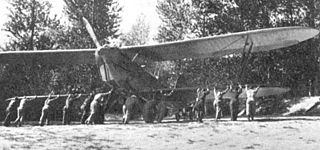
The Aero A.101 was a biplane light bomber and reconnaissance aircraft built in Czechoslovakia during the 1930s.

The Aero A.200 was a sportsplane of Czechoslovakia, designed and built specifically to compete in Challenge 1934, the European touring plane championships. It was a four-seater low-wing monoplane.

The Aero A.304 was a Czechoslovakian bomber aircraft that first flew in 1937. It had originally been developed as an airliner, the A.204, but when Aero could not find buyers for the design, it was militarised and successfully marketed to the Czechoslovak Air Force.

The Avia B.135 was a Czechoslovak cantilever monoplane fighter aircraft. It was the production version of the Avia B.35 developed shortly before the war, based on the B.35/3 prototype but featuring a new all-metal wing.
The Letov Š-16 was a Czechoslovak single-engined, two-seat biplane bomber. It was designed by Alois Šmolík at Letov Kbely. The Š-16 first flew in 1926.

The Letov Š-28 was a Czechoslovak single-engined, two-seat reconnaissance aircraft. It was manufactured by Letov Kbely in a number of versions with different powerplants. The most important version was the Š-328, which was produced in relatively high quantities.

The Tupolev Tu-12 was an experimental Soviet jet-powered medium bomber developed from the successful piston-engined Tupolev Tu-2 bomber after the end of World War II. It was designed as an interim aircraft to familiarize Tupolev and the Soviet Air Forces (VVS) with the issues involved with jet-engined bombers.
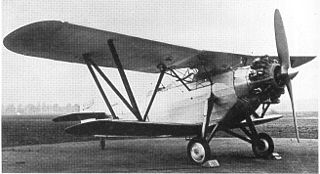
The Bristol Type 118 was a general-purpose military aircraft, a two-seat biplane built by the Bristol Aeroplane Company in the early 1930s, powered by a Bristol Mercury radial engine and aimed at overseas markets. The Type 120 was a Bristol Pegasus-engined variant entered into an Air Ministry competition and later used for armament tests. Two aircraft were built.
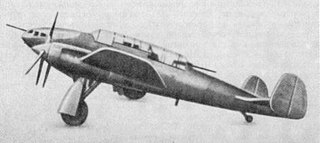
The Polikarpov VIT-2 was a Soviet twin-engined ground attack aircraft developed before World War II. A single prototype was built in 1938 for evaluation purposes. Although a promising design it was recommended that it be introduced into production as a high-speed dive bomber with a reduced armament to increase its speed.
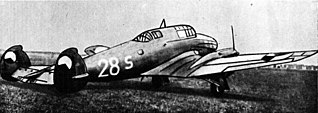
The Avia B.158 was a prototype Czechoslovak twin-engined light bomber aircraft of the 1930s. Only a single example was built and it was abandoned, following the German occupation of Czechoslovakia in March 1939.
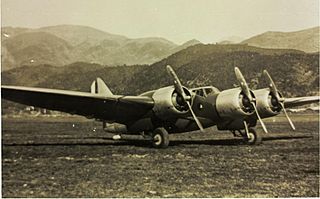
The Piaggio P.16 was an Italian heavy bomber designed and built by Piaggio for the Regia Aeronautica.
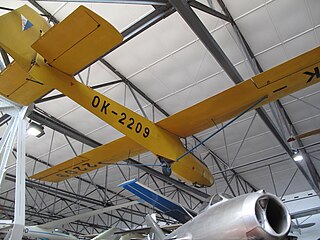
The Let LF-109 Pionýr is a glider aircraft developed by Czechoslovak manufacturer Let Kunovice. It was designed as a two-seater training aircraft and the first flight was performed in March 1950. The plane features a simple and robust design of a fabric-covered steel tube fuselage and has good flight characteristics. In total, about 470 aircraft were built.
The SNCAO CAO.700 was a French prototype four-engined bomber of all-metal construction, developed shortly prior to and during the Second World War. Only a single example was built, and was on the point of being flown for the first timewhen the surrender of France in June 1940 ended testing and development of the aircraft.

The LWF model V is an American two-seat reconnaissance and training biplane built during World War One, and used for a short period afterwards. A variant specially built to test the Liberty L-12 aircraft engine, the model F, was the first aircraft to fly powered by that widely used engine.

The Praga E-51 is a Czechoslovakian reconnaissance aircraft and light bomber built by Praga in the 1930s. Development was halted by the annexation of Czechoslovakia by Germany, after only one prototype had been built. The appearance of the construction is very reminiscent of the contemporary twin engined fighter, the Fokker G.I from Holland.
The Hodek Hk-101 was a Czechoslovakian twin-engined, two seat light aircraft. Two prototypes were built in 1947, but development was abandoned after the 1948 Czechoslovak coup d'état.
